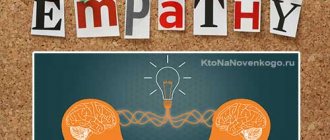Types of identification
It can be primary and secondary. In the first case, we are talking about the child's identification with the mother, and later with the parent of the same sex as the child. In the second case, the child’s identification with other people and groups in the process of growing up is implied. It, in turn, is divided into several more subspecies. Let's take a closer look.
Situational
This is clearly noticeable in children during games, in adults - at a meeting, when meeting a new person, etc. In general, in some specific situation or conditions, an individual tries to become the same as a person significant to him.
Group
This is a stable type. It implies an individual’s commitment to the values and goals of a group. Outside of it, the subject lives by the same rules. However, sometimes group identity is situational and superficial. A person does not accept the goals and interests of the group as his own. Once he leaves this group, he will behave differently.
Cultural
This is a process of identification, adaptation to the culture of society. A person needs to find a balance between internal and external. For example, between traditions and innovation, goals and means. The subject has to realize his own potential within a particular society. Accept the norms and values of this world.
Social
This is the process of a person identifying himself as an important, active participant in society. He perceives himself as a social agent, feels that he belongs to some social group, and can pronounce “WE” with complete confidence.
Personal
This is a person’s assimilation to himself, that is, the preservation of his uniqueness. Implies unity of goals, interests, views, beliefs, motives, meanings. No matter what group a person belongs to, he always retains a set of stable characteristics.
Finding a balance between personal and public is one of the most difficult problems in psychology. Sometimes a person becomes so similar to others that he loses himself. He dissolves into other people. He forgets about his essence, loses the unity of his Self, ceases to understand himself, forgets his life story.
Collectivist
Formed in the process of general activity. The experiences of one person are transmitted to others and become motives for common activity. Collectivist identification manifests itself in complicity and sympathy. Each team member shares the failures and successes of the other. That is, a person feels others as himself.
Gender
The process of realizing which gender (collective image of a man and a woman) a person considers himself to be. It doesn't always match the gender. Gender identity provides the answer to the question “Who do I feel like: a man or a woman?” At the same time, a person understands perfectly well which gender he belongs to. For example, a man can recognize his gender, but at the same time be vulnerable, sensitive, gentle, that is, have a set of traits that are generally characteristic of women. Likewise, a woman, despite her gender, can feel like a “man in a skirt.”
Pain points of personal identity
What are the painful points of a person’s self-identification? These are those characteristics of an individual that a person knows about, but considers them negative traits. For example, at the socio-professional level of self-identification, this may be the lack of a specific skill necessary in professional activity, and at the level of values and ideology - excessive love for animals combined with relative indifference to people’s troubles. When communicating with other people, a person experiences psychological discomfort if he has to talk about “painful” topics relating to his personality.
Development
Since Freud proposed the term and also named the types of human identification (erotic and mimetic), the influence of identification and its role in the formation of personality has been studied by many philosophers and psychologists. Freud, who laid the foundations of the doctrine, called identification with those people whom we would like to possess erotic.
The second type he identified was aimed at the kind of people we would like to be. Through the process of mimetic identification, the crowd becomes controllable, as all its elements abandon their ideals and accept a single, mass ideal expressed in the leader.
The concept of identification is actively used in social psychology. The most original theories are associated with the names of Tajfel and Erikson. Tajfel developed the theory of social identity. Groups to which people belong are a source of pride and self-respect, they integrate a person into the social world and create a sense of belonging to a large group of people.
Recommended: What is personal identification?
The negative aspect of such a process is the attempt to increase one's self-esteem by exalting the group to which a person belongs and painting other groups with black paint. The division into “us” and “them” leads to a decrease in empathy towards the latter
At the same time, it becomes important for us to help and support those who are part of the “we” group
The prejudices that arise in a culture as a result of this division sometimes result in large-scale and violent conflicts. Examples are racism and genocide. Social identification leads to an exaggeration of differences between groups and an erasure of differences within them. Thus, we do not see personalities, individualities behind all this, and we begin to perceive those around us from other groups stereotypically.
Tajfel and Turner identified three stages of identification. We first classify objects to understand and identify them. The name of this stage is categorization. There is nothing wrong with categorization itself, since without it it would be quite difficult for us to live; categories give us quite a lot of information about a person and his roles in the group.
At the second stage, we ourselves begin to attribute ourselves to one of the groups that we identified earlier. And only the stage of social comparison is fraught with threats. When we have already classified ourselves as a member of a certain group and begin to compare it with others, we may be prejudiced against their representatives, especially if our groups compete. To communicate productively and sustainably, you need to clear your thinking of unconscious attempts to denigrate people from other groups.
We recommend: The concept of identity in psychology
Identification is an important term in Erikson's identity theory. To find oneself, to become an individual, a person must make many identifications with others and integrate them. The acquisition of identity is accompanied by an awareness of one’s inseparability from the social and cultural field, the perception of the integrity of the individual, the continuity of its development through identification with different social groups. In his theory, identification is the path to achieving identity.
What is Personal Identification
In psychology, personality identification is understood as a person’s attribution to himself of features, qualities, properties, external signs and internal characteristics of a subject. According to this, he partially or completely transforms himself.
Personal identification is likeness to a person, group, character. This process is called identification. Derived from the Latin word identificare, which means “identification.” Moreover, most often the person himself does not understand that he is adopting someone else’s characteristics. This is why it can be very difficult to distinguish the true “I” from borrowings, which is why we sometimes do not know what it means to “be ourselves.”
Until the age of three, children talk about themselves in the third person, because until this moment they do not identify themselves as an independent person. But from the age of three we begin to actively learn about ourselves: gender, age, nationality, etc. We then begin to accumulate social experiences by identifying ourselves with family and friends. Every year this process becomes more and more difficult, and the risk of losing oneself increases. Individuals completely forget about themselves and dissolve in other people, things, and phenomena.
Identifying yourself with another person is comparing your experience with his experience, building your life similar to his life. “We are so similar”, “I am the same as you” - such phrases can describe the essence of this phenomenon.
Identification of a person by external and internal characteristics
Freud made a special contribution to the study of personality assimilation. He believed that this is an unconscious merging of a person with others, imitation of them. The individual becomes infected, as it were, with other people’s thoughts, emotions, interests, and habits. This is probably why they say “tell me who your friend is and I will tell you who you are.” According to Freud, comparison of a person according to internal and external characteristics occurs by comparing characteristics or by determining the essence (membership in a group).
The process of identifying oneself with others
Identification comes in three levels (stages, types):
- Acceptance of external values. An example is the worship of a star. The fan watches every performance of the idol, perceives every fall and every rise as his own victories and failures. He follows him around the cities, lives his life. Such identification helps to escape from real problems and worries. A person lives according to instructions, a script. Living in a fictional world is comfortable and not scary.
- Acceptance of internal values. These are the “masks” that each of us wears. This is the acceptance of the values of society, imitation of the norms that others promote. Simply put, we hide our essence and appear as specific people in a specific place and time want us to be. There is nothing wrong with this as long as a person understands where the mask is and where he is real, and knows how to manage it.
- Comparison with oneself (self-identification). For example, in a dream we experience and feel everything as if it were happening in reality, but at the same time we understand that this is far from our reality. This is the most difficult and deep level. The level of self-compassion, knowledge and understanding of your body, feelings, desires, subconscious. This is communication with yourself beyond all masks and images.
How to become yourself? It is important to understand your value and realize that each person has their own path to happiness. To be yourself, you need to constantly leave your comfort zone, develop, learn your needs, abilities, interests.
You need to learn to look at yourself from the outside. At the same time, it is important to develop awareness and learn to live here and now. You need to break out of the usual framework of identification, remember what you once were, what you wanted.
We will talk more about identification and self-identification in other articles.
Loss of identity
“I’ve lost myself”, “I don’t know who I am”, “I’m confused in myself”, “I don’t know where I’m going, what I want” - these are the thoughts that come to a person who has lost his identity. A person loses faith in himself, understanding of his place in the world, the integrity of his Self. An exaggerated example of loss of identity is mentally ill people who consider themselves Napoleons, Jesus, etc. This example belongs to the pathological extreme; psychiatry deals with them. We'll talk about what psychologists work with.
Causes
Causes of loss of identity (personal crisis):
- drastic changes in society (for example, many people faced this problem when the USSR collapsed);
- serious and unfavorable changes in the life of the person himself (dismissal, bankruptcy, divorce, someone’s death);
- age crisis, for example, midlife crisis.
In general, the cause of loss of personal identity is stress. Moreover, this can be both an unpleasant experience and a very pleasant one. For example, a wedding, a long-awaited move to another country, or the birth of a child can also cause a loss of identity. This occurs due to any strong psychological shock.
Symptoms and signs
Symptoms of loss of identity:
- frequent doubts such as “Why don’t I leave this job?”, “What am I doing here?”, “Why am I living with this person?”;
- constant reflection on the meaning of life and purpose;
- feeling of uncertainty;
- frustration;
- chronic anxiety;
- inability to form a system of values and stable beliefs;
- doubts about the correctness of your actions;
- fear of the future;
- indecisiveness in actions.
For some people, the crisis is visible to the naked eye. They spend their time aimlessly, wander, they do not have a job or they change it often, or they are stuck in one position (usually a low one). Some people can't even get an education. Some people end up in bad company, some end up in prison. But most people just exist. They are unhappy, they do not understand what they want and what they can, where they need to move. In general, a person in such a state does not know who he is, and therefore cannot be himself and suffers greatly from this.
Danger of condition
How dangerous is this condition:
- exhaustion,
- maladjustment,
- desocialization,
- insulation,
- depression,
- neuroses,
- suicide,
- dependencies.
Some people try to console themselves with alcohol, drugs, or casual sex. Someone begins to grab onto everything in a row (any type of activity), but this only increases the feeling of emptiness and frustration. Others simply become depressed and lock themselves at home, waiting for death.
What to do
Remember where you last saw yourself. Try to remember a time when you felt good. What kind of person were you at that moment, where were you, who was nearby. Start with an analysis of childhood and gradually move towards the present. Remember what you could do, what you dreamed of, what you wanted. Why did they refuse this? Maybe it's time to return to this again? Think about what used to bring you joy, what was the meaning of life, an incentive. If you can't bring back exactly this, then think about something you can replace that is similar to this.
Thus, you need to find the reason (what brought you down) and work with this area. It is necessary to go through all stages of development again, starting from childhood. It's better to consult a specialist. In some cases, just one consultation is enough.
Personal identification: features and types
The process of identification is characterized by relative limitations. A person is designed in such a way that he has the ability to liken only those who have at least some similar traits with him. Through identification, an instrument of understanding is developed. It is a kind of mirror, reflecting the general and promoting better communication.
Personal identification is divided into the following types:
1. Situational
This type of identification most often finds its manifestation in children's amusements. Thus, one of girls’ favorite games is still “mother-daughter”, during which the child’s behavior in future family conditions is “rehearsed”.
2. Collectivist
A person often likens himself to the community in which he moves. The individual realizes that he is one of the constituent elements of the collective “puzzle”. The goals and values of a given social group become his own. This is how “corporate” thinking is formed.
3. Personal
In psychological practice, this type of personal identification is considered as a person’s awareness of his own life attitudes and motives of behavior as a subject of activity. This is what characterizes the psychological integrity of the individual, his “self.”
4. Ethnic or national
Due to the fact that each of us lives in a certain culture, we feel an inextricable connection with it. Such an understanding is formed in a person on the basis of emotional comprehension of the peculiarities of the customs and mentality of the nationality to which he belongs.
5. Political
In this case, one observes identification of oneself with a specific socio-political position. A person is aware of his attitudes regarding any party, ideological movement, political institution or leader.
Definition of the concept
Self-identification is the basis of one’s “I”, an assessment of one’s own abilities, personality traits, personal, physical and moral characteristics. Each person determines for himself how capable he is of performing a particular activity, achieving goals, displaying feelings or physical qualities. Based on this data, a person can classify himself as a member of one or another group: religious, sports, intellectual and others. For example, a person who is aware of his ability to draw may classify himself as an artist, and someone who sees himself as having excellent physical abilities identifies himself as an athlete. The only way for a person to self-identify is reflection: only by deeply reflecting on himself can a person understand who he is, what he wants and where he is going.
Social identification
Speaking about social identification in psychology largely implies views and attitudes towards the problems of a certain age, class, professional or some other group.
Each person divides society into “us” and “strangers”. In order to maintain good relationships, interact competently and be protected by like-minded people, a person has to share the views on life that this very group preaches.
A person lives with the problems he hears about, even if they do not concern him.
A person does not deceive himself, he listens to the opinions of others, which he considers authoritative, as a result of which he can look differently at certain problems, become in solidarity with his group, or may share them initially.
We constantly ask ourselves: “Why am I with these people? What unites us? Are we really close? Having heard an unusual opinion, we do not immediately reject it, as would happen in a group to which we do not belong.
Example
There are a great many examples of social identification. You know them yourself
Probably everyone has a colleague who is treated with distrust, caution, and, to put it mildly, disliked. As soon as someone “good” comes to the team, he immediately begins to copy this behavior, without even really understanding people, but by “trusting” the society of “his own”
The Great Ego
Attitudes towards personality in Soviet and Western schools of psychology were under pressure from ideology. In the USSR, psychology had to provide evidence of the correctness of the ideas of collectivism.
In Europe and America, psychologists were in demand as private and corporate consultants. Therefore, much more research has been devoted to personality and its self-identification.
Several main directions have emerged:
- Psychoanalysis.
- Behaviorism.
- Cognitivism.
- Symbolic interactionism.
The existence of different schools and competition between them reflects the complexity of the problem. A person turns to a psychotherapist and psychoanalyst when he realizes that something is “wrong” in his life. Loss of self-identity causes discomfort and stress.
Each person is individual. Differences in approaches to diagnosis and therapy allow everyone to find a specialist whose methods are most effective in a particular situation.
Identification in Freudian philosophy?
The famous Austrian expert on psychoanalysis, Sigmund Freud, created his own concept of this phenomenon. He was the first to identify the following categories of identification:
1. Anaclitic
This type of mental reaction is characteristic of children who identify themselves with a parent who supports and helps them. For example, if a mother shows maximum attention and tenderness towards her child, then the child will ultimately want to be just like her.
2. Identification with the aggressor
The Austrian psychologist viewed this category as an automatic reaction caused by the need for protection from the influence of a person with more power. So, if a child is afraid of his father’s punishment, he subconsciously strives to become like his parent. In this case, the child thinks, he will have the same influence and the same power.
In psychological practice, there are often cases when a patient identifies himself with the specialist treating him. Freud warned his colleagues against the narcissistic temptation to imagine themselves as the all-powerful “saviors” of their clients. Despite this, this taboo continues to be violated more often than other therapeutic prohibitions.
Conclusion
Identification gives us the opportunity to better understand other people by putting ourselves in their place. Many phenomena of the surrounding world are difficult to perceive individually. A person needs to compare himself with a specific image, which is achieved through identification.
Variety of methods used for identification
To identify certain objects, various identification methods are used.
The simplest method of unique names has been known since ancient times. It is thanks to him that cities, countries, planets, and so on have their special names.
Many objects that we encounter in everyday life have their own numbers. Their assignment is due to the method of identification using the numbers that make up the number, which is one of the most widely used.
To identify products or documentation, conventional designation methods are widely used, which are divided into mnemonic, classification and mnemonic classification.
To systematize various objects and simplify the collection of necessary information about them, the classification method is used.
If the features of an object are identified according to certain standards described in regulatory or technical documents, then the reference identification method is used.
If a certain object is identified by describing its qualities, characteristics, dimensions, then the descriptive method is used.
And if you add a link to regulatory documentation to the description, then this identification method will be called descriptive-referential.
Empathy
Over time, a person will move away from his parents and may adopt the behavior and character traits of literary heroes. Bravery in extreme situations, honesty, valor, etc. can be the merit of the books on which a child or teenager was raised. I have a separate article about what empathy is.
The impact of films is weaker, since the period of their influence on the human psyche is short-lived. Identifying with the hero of a work of art helps to better understand the work and evokes vivid emotions and experiences.
At a young age, many girls show a penchant for reading romantic literature. From books they learn more about how true ladies behave, as a result of which they themselves develop such traits as morality, delicacy, and femininity.
You can use the desire for identification for your own purposes. For example, during a divorce, it is recommended to read books about strong women, or heroic epics to develop self-confidence.
By the way, all this is written very interestingly in Yulia Fomina’s book “Psychological characteristics of fairy-tale characters and personal identification.” It tells exactly how fairy tales influence a child and what consequences they lead to in adulthood. Who knows, maybe in this work lies the answer to the question: “Why am I like this?”
Introduction
The term “personal identification”, derived from the medieval Latin word identifico – “I identify”, denotes a mechanism whose operation is based on the existence of an emotional connection between an individual and other people, primarily his parents, leading to assimilation, most often unconsciously, with these significant others. Focusing on another person as a model significantly increases the indicators of social learning. Due to identification, a small child develops behavioral stereotypes that form personality traits, determines value orientations and gender-role identity - this is an established empirical fact.
12 pp., 5840 words
“Personality: main stages and mechanisms of development” psychology
... of this work. Purpose of the work: to consider the content of personality development, its stages and mechanisms. Objectives: To reveal the content of the concept of “Personality”; Consider the main stages of personality development: childhood, adolescence, maturity; Explore the mechanisms of personality development. The concept of “Personality” The concept of “personality” is used to characterize a person...
Identification also acts as one of the mechanisms of cognition and understanding of another person. There are many experimental studies of the process of identification and elucidation of its role in the communication process. In particular, a close connection has been established between identification and another phenomenon that is similar in content - empathy.
The phenomenon of identification was first described in the works of Z. Freud in 1899 and is studied in detail by both psychoanalysts and behaviorist or cognitive science-oriented researchers. In Soviet psychological science, many interesting theoretical and empirical studies have been devoted to the study of this phenomenon (Vygotsky L.S., Kon I.S., Mukhina V.S., etc.)
The purpose of this work is to reveal the concept of “personal identification”. This goal determines the solution of the following tasks:
- Consider the relationship between the concepts of “identification” and “identity”;
- Describe the mechanism of personality identification in ontogenesis;
- Give an idea of some domestic and foreign theories of personal identification.
What does the concept of identification include?
Identification is the identification of oneself with another person, character or even a group of people, as well as further unconscious assimilation.
A person lives in society and encounters other “characters” in whom he sees traits and qualities that are not characteristic of him. To make communication easier, a person takes on some characteristics. The more we come into contact with a certain person, the more we absorb from him. This is a defense mechanism that allows you to avoid conflicts. This is relative to other people.
When we look inside ourselves, we can see many people.
You can identify yourself not only with a real person. Some qualities are adopted from books. The human psyche is aimed at constant self-improvement; we unconsciously strive to become better, and for this we need to have an idea of the ideal. These may be in books.
Identification can also be cultural, ethnic, collective, but I would like to start, of course, from childhood.
Symbolic interactionism
Adherents of this paradigm in sociology believe that a person reacts not to direct stimuli, but to their images. Language is considered the main symbolic system. “Understanding” by group members of each other without words is explained by the fact that the primary interaction is gesture and facial expressions.
Since a person cannot form and develop outside of society, he self-realizes in the process of interactions, “interactions.” Personality manifests itself only as a result of communications. The exchange of people’s ideas about themselves and others forms a “primary group” with the closest and most effective connections.
The personality is in constant dynamics: assessing the situation, its correlation with familiar symbols and in the interaction or exchange of symbols.
Identification in criminology
Criminologists understand identification as the identification of a wanted criminal. In the process of operational-search activities (OPM), specialists use several identification methods at once.
Identification in criminology is the identification (establishment) of a person based on dynamic and static characteristics. The first includes facial expressions, speech, gestures, and gait. The second includes fingerprints, smell, composition of biological fluids. Sometimes for identification they use a sketch compiled from the words of witnesses, a photograph or a computer model of a person.
Conditions for the identification procedure:
- Preservation of the rights and freedoms of all participants.
- Maintaining the safety of witnesses, maintaining secrecy.
- Drawing up a report, extract, certificate on the results of the event.
- The final document describing the conditions under which identification took place and the signs of compliance. Audio, video and photographic materials are included.
Personal identification can take place in natural or artificial conditions. That is, in those places where the suspect should appear or at the police department.
Stages
Stages of identification from forensic science:
- Preparation. Experts must study the available data about a specific person, evaluate the information, and weed out useless and false information. If there is enough information, a research plan is drawn up and technical means are prepared.
- Analytics. The specialist begins to study the properties, signs of objects and subjects that are involved in the case.
- Experiment. It is needed to obtain samples of the subjects being studied.
- Comparison. Stage of object identification.
The last stage is summarizing the information received, analyzing it, drawing conclusions, and recording the results. The results of the examination are recorded in special acts.
Identification mechanisms in psychology
Identification mechanisms come in various forms. For example, imitation, identification, immersion in the world of another person, the potential opportunity to do so, and so on.
We dissolve into each other.
The entire internal and external world of a person can be identified: worldview, character traits, motives, interests, goals, and even manners of behavior and communication.
If you haven’t seen a friend for a long time, but have a good memory and observation skills, you may notice how, for example, he began to do things unusual for him - fiddling with his lips, squinting or speaking through his nose. Ask who of his friends does this, and you will find out the name of the person he is targeting.
Identification - what is it?
Translated from Latin, this term means “identification.” To identify oneself with another means to focus on its stable parameters and, depending on this, “tune” one’s personality. Experts break down the definition of identification into the following components:
- building an emotional connection: implementing another person’s feelings into one’s own inner world, accepting his life guidelines and values;
- projecting oneself onto this individual, seeing him as a continuation of one’s personality, giving the interlocutor the characteristics of one’s character, desires, feelings;
- “putting” oneself in the place of a partner: imaginary relocation into the world of another individual to assimilate his motives of behavior.
The term “identification” is also used by psychologists when an individual “gets used to” the image of a literary or cinematic character. In this case, empathic experiences and mental reincarnation arise.
Who among the boys in childhood did not want to try on the role of the fearless and noble d'Artagnan - the hero of the immortal novel by A. Dumas? Is there really a girl who doesn’t dream of a handsome prince and doesn’t imagine herself as a meek Cinderella or faithful Assol?
History of discovery and study
The term “identification” has different interpretations and features. According to the teachings of Sigmund Freud, these are:
- A defensive reaction due to fear of punishment for aggressive or sexual desires.
- The unconscious identity of one subject with another, the motive of which is reflected in the fear of losing love.
In psychoanalysis, identification is emotional. It is the only mechanism by which personality is formed. At an unconscious level, the parental prototype is reproduced.
From the point of view of behaviorists, identification is associated with the concept:
- role theories;
- formation, reinforcement of secondary needs;
- cognitivism.
Identification manifests itself at a conscious and unconscious level.
What types of similarity exist?
Psychologists have not yet come to a consensus on what the term “identify” includes; the meaning can be quite voluminous. Freud in his works pointed out that the identification of a person by external and internal signs occurs either by establishing the equivalence of taking into account signs (for example, identifying criminals), or by defining the essence, i.e. belonging to a certain group.
The psychologist also believed that identification is an unconscious action of merging an individual with other people in whole or in part, i.e. a kind of imitation. Such identification means infection with other people's thoughts and ideas, getting used to the emotions of the object of imitation.
We recommend: What is an alter ego?
Modern psychologists distinguish three types of identification. The first is the most common and means merging with external values. For example, you really like a famous figure skater, you watch all his performances, worry about every injury or fall on the ice. Any reward for your idol is your reward, his failure is your failure. You become so accustomed to the new image that you no longer feel the difference between yourself and this person.
Identification with internal values means that a person is completely immersed in the system of conventional coordinates “good - bad.” In other words, each of us has a true character and individual traits, which, under the influence of upbringing, are transformed into something different that meets the requirements of society.
A person puts on a mask facing others and considers this normal. But as soon as the mask encounters the inner “I,” the true values are replaced by the conditional values of the mask.
Identification with one’s own personality is the third level. For example, some people quite often have vivid, eventful dreams; they completely sincerely empathize with themselves, take everything that happens at face value, and completely merge with the character of the dreams.
However, upon awakening, they realize that it was just a dream, the reality around them is a completely different matter. This level of identification is the deepest; it consists of identifying oneself with the body, personality, feelings, secret desires, aspirations, without masks and roles imposed from outside.
Collective identification
Collective or group identification arises depending on the society in which a person finds himself. The desire for success, study or destructive behavior also does not arise out of nowhere. A child or an adult, communicating in certain circles, may deviate from a given course, the concepts of good and evil are blurred or replaced by others.
Single friends of a recently married man may be surprised by his changes and complain about his wife’s influence. In fact, this is a vital mechanism in which there is nothing reprehensible or unnatural. As they say, we will all be there.
Example
I once had to communicate with a young man who cheated on his own wife only because all his friends did so. They often got together and discussed victories on the love front. Cheating did not make my friend happy, nor did communicating with his friends, whom he could not refuse.
The woman is getting married.
How many women get married or give birth just because all their classmates have already done the same?
In fact, it can be very difficult to resist authoritative opinion, since our brain strives for an ideal life, the images of which it captures in the surrounding society.
No matter how much they laugh at the owners of Apple products, as soon as a person has the opportunity, he most often buys equipment from this company.
4.1. Identification of citizens
Issues of assigning an identifier to the personal data of citizens must be determined by a regulatory legal act, which must define where, when, by whom the identifier is assigned, by whom it is maintained, where it is stored and how it is applied. If there are several identifiers, the areas of their application and the areas of their contact must be described. Without legal and regulatory reinforcement of these fundamental norms, the process of using basic identifiers is doomed to failure.
Social identification
A person has a deep need for recognition of his inner beliefs by society. In certain situations, an individual needs to protect “his own” against the unfavorable circumstances of the surrounding world. The cementing element is the commonality of mentality traits of an individual participant in society and a group.
The inability to socially identify has a negative impact on the psychological health of the individual. If a person notices that the group to which he belongs is valued low by society, he begins to develop the following patterns of behavior:
1. “Internalization of a devalued image”
Using this strategy, the individual resignedly accepts himself as “bad.” He refuses to protest and seems to be trying to go into the shadows so as not to “be an eyesore.” At the same time, the person pretends not to notice how society discriminates against him on certain grounds. He capitulates without taking any measures to improve his situation.
2. Aggressive resistance
In this case, one identifies oneself as an active “fighter for justice.” A person chooses a protest line of behavior and counterattacks those who express dissatisfaction or contempt towards him.
As a rule, such an individual adopts ridicule or reciprocal disdain for the foundations of critics. He can also act on the principle “the worse, the better” and emphasize in his behavior precisely those traits that are negatively perceived by the dominant culture.
3. Assimilation
Having chosen this path, a person strives to get out of the image repelled by society and become “like everyone else.” The search to determine the identification of one’s person and dominant ideas can be observed in various planes: from adapting the image to general ideas to radical measures, for example, changing the name. By adapting to others, the individual thus betrays the group to which until recently he belonged.
4. Compromise
This strategy has a second name - “creating a critical personality.” A person does not renounce “his own,” but acquires some features characteristic of the prevailing belief system. He may accept some negative assessments of his community and disagree with others.











